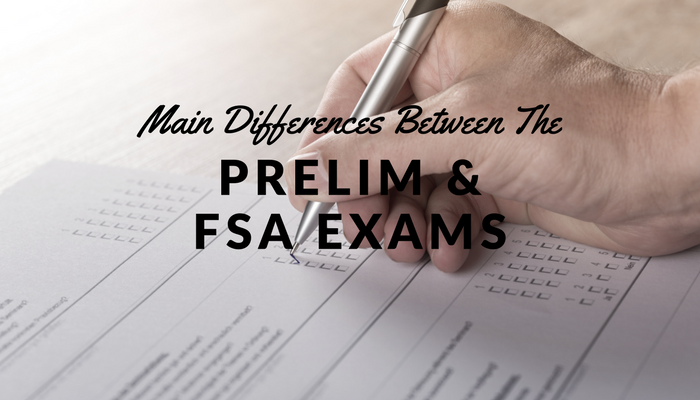You finish the last preliminary exam, and you’ve finally figured out a successful study approach.
Then, you’re thrown a curveball with the Fellowship exam format. These written exams are much different than the multiple-choice style.
So, what are the biggest changes between the preliminary and Fellowship exams? How should you change your study strategy to adapt?
1. Focus on principle over process
Defining principle vs. process
What’s the difference between principle vs. process when studying for actuarial exams?
The process is the actual steps to solve a formula – recognizing variables, finding the right inputs, and using your calculator to produce an output.
The principle is the underlying concept behind the formula – what purpose does it serve? What question or business problem are we trying to solve, and how does this formula lead us to an answer?
To illustrate this contrast: You can become efficient at solving prospective reserve questions using the formulas in Exam MLC (you quickly solve the Insurance, Premium and Annuity formula components).
However, if someone asks you how much money to hold today given a string of non-level future benefits and premiums in Excel (with a discount rate), you may be lost on how to answer.
The second question doesn’t fit your memorized reserve formula inputs, so you struggle to find a solution even though the underlying goal hasn’t changed.
That is, you can become good at a particular process (prospective reserve formula) without necessarily learning the principles (fundamental question you are trying to answer).
Knowledge of the process is fragile – you become good at answering questions that fit your pre-defined knowledge framework, but you flounder when you see an unfamiliar question.
Understanding the principles helps you tackle these unfamiliar questions – you can reason from first principles to solve them.
Prelims vs. Fellowship exams – shifting the focus toward principles
You can pass the prelim exams by learning the process without fully understanding the principles.
You can do so many practice problems that eventually the exam questions fall within your realm of familiarity. You recognize the problem setup, recall the right formula, plug in the numbers and are good to go. This was my approach to the first prelim exams.
A better approach (and one that we describe in our book), emphasizes the principles in addition to the process. If you understand the principles, you can be more comfortable solving problems that you’ve never seen before – your knowledge is less fragile.
You don’t need hundreds of practice problems because you are comfortable reasoning through unfamiliar questions.
Understanding principles is not necessary for passing the prelim exams (I am living proof with my first two exams). But it becomes critical on the Fellowship exams.
You will not only be asked to calculate answers, but you’ll have to make recommendations for further actions based on your results.
In addition to knowing how to apply a formula, you need to understand when and where it is appropriate. You need to compare/contrast different approaches to solving a problem and analyze or critique given arguments.
On the Fellowship exams, you are almost guaranteed to see problems that differ from anything you have practiced. The best way to prepare for this style of exam is to place heavy emphasis on principles.
Not only will this style of studying help pass the Fellowship exams, but it will benefit your actuarial career. After all, most problems we encounter in the workplace don’t fall within the framework of a formula (process) we memorized from our manuals.
In the first section of Actuarial Exam Tactics, we discuss more ways to focus on understanding the principles vs. the process.
2. Lack of practice problems
On the prelim exams, you have an endless supply of practice problems between the SOA sample questions, past exams, and problems from your manual.
Not only are these problems abundant, but they closely resemble what you’ll see on the actual exam.
For the Fellowship exams, you will not see the same quantity or quality of problems.
There are some study aids that advertise a lot of practice problems – these may be a useful starting point, but they do not closely resemble actual exam questions.
Even the SOA past exams have limited utility, as the syllabi change each year and some past questions become irrelevant.
For students who used practice problems as a key component of their study strategy for the prelims, this is a staggering roadblock.
Unfortunately, many people resort to re-reading the source material in absence of better review tools – this is a mistake.
Re-reading the material is a passive and inefficient way to review. Even in absence of practice problems, you can find other self-testing mechanisms that test your retrieval of the information (more on the benefits and examples of active recall in our sample chapter).
I previously wrote about one note-taking method centered on creating your own questions.
Even if you don’t use this exact note-taking strategy, you could do something as simple as writing a half-page summary of the material one day after the initial reading (write this summary from memory, referring back to the source as needed to fill in gaps).
Regardless of the method, make sure you find a self-testing review tool to replace the abundant practice problems you used on the prelims.
Final Thoughts
The Fellowship exams present a unique challenge compared to the prelims, and you must adjust your study strategy accordingly. Just as it took a while to get used to studying for the prelim exams, it will take time to adjust to the new format of the Fellowship exams.
Hopefully, this article helps expedite that adjustment period, so you don’t have to repeat some of my same mistakes.
Study Smart, Pass Fast, Live Life
Mike & Roy

